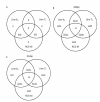Temporal transcriptome changes induced by MDV in Marek's disease-resistant and -susceptible inbred chickens
- PMID: 21992110
- PMCID: PMC3269463
- DOI: 10.1186/1471-2164-12-501
Temporal transcriptome changes induced by MDV in Marek's disease-resistant and -susceptible inbred chickens
Abstract
Background: Marek's disease (MD) is a lymphoproliferative disease in chickens caused by Marek's disease virus (MDV) and characterized by T cell lymphoma and infiltration of lymphoid cells into various organs such as liver, spleen, peripheral nerves and muscle. Resistance to MD and disease risk have long been thought to be influenced both by genetic and environmental factors, the combination of which contributes to the observed outcome in an individual. We hypothesize that after MDV infection, genes related to MD-resistance or -susceptibility may exhibit different trends in transcriptional activity in chicken lines having a varying degree of resistance to MD.
Results: In order to study the mechanisms of resistance and susceptibility to MD, we performed genome-wide temporal expression analysis in spleen tissues from MD-resistant line 63, susceptible line 72 and recombinant congenic strain M (RCS-M) that has a phenotype intermediate between lines 63 and 72 after MDV infection. Three time points of the MDV life cycle in chicken were selected for study: 5 days post infection (dpi), 10dpi and 21dpi, representing the early cytolytic, latent and late cytolytic stages, respectively. We observed similar gene expression profiles at the three time points in line 63 and RCS-M chickens that are both different from line 72. Pathway analysis using Ingenuity Pathway Analysis (IPA) showed that MDV can broadly influence the chickens irrespective of whether they are resistant or susceptible to MD. However, some pathways like cardiac arrhythmia and cardiovascular disease were found to be affected only in line 72; while some networks related to cell-mediated immune response and antigen presentation were enriched only in line 63 and RCS-M. We identified 78 and 30 candidate genes associated with MD resistance, at 10 and 21dpi respectively, by considering genes having the same trend of expression change after MDV infection in lines 63 and RCS-M. On the other hand, by considering genes with the same trend of expression change after MDV infection in lines 72 and RCS-M, we identified 78 and 43 genes at 10 and 21dpi, respectively, which may be associated with MD-susceptibility.
Conclusions: By testing temporal transcriptome changes using three representative chicken lines with different resistance to MD, we identified 108 candidate genes for MD-resistance and 121 candidate genes for MD-susceptibility over the three time points. Genes included in our resistance or susceptibility genes lists that are also involved in more than 5 biofunctions, such as CD8α, IL8, USP18, and CTLA4, are considered to be important genes involved in MD-resistance or -susceptibility. We were also able to identify several biofunctions related with immune response that we believe play an important role in MD-resistance.
Figures


Similar articles
-
RNA Sequencing revealed differentially expressed genes functionally associated with immunity and tumor suppression during latent phase infection of a vv + MDV in chickens.Sci Rep. 2019 Oct 2;9(1):14182. doi: 10.1038/s41598-019-50561-x. Sci Rep. 2019. PMID: 31578366 Free PMC article.
-
Marek's disease virus-induced immunosuppression: array analysis of chicken immune response gene expression profiling.Viral Immunol. 2010 Jun;23(3):309-19. doi: 10.1089/vim.2009.0079. Viral Immunol. 2010. PMID: 20565294
-
Transcriptional Profiles Associated with Marek's Disease Virus in Bursa and Spleen Lymphocytes Reveal Contrasting Immune Responses during Early Cytolytic Infection.Viruses. 2020 Mar 23;12(3):354. doi: 10.3390/v12030354. Viruses. 2020. PMID: 32210095 Free PMC article.
-
Transcriptome and proteome profiling of host responses to Marek's disease virus in chickens.Vet Immunol Immunopathol. 2010 Dec 15;138(4):292-302. doi: 10.1016/j.vetimm.2010.10.007. Epub 2010 Oct 12. Vet Immunol Immunopathol. 2010. PMID: 21067815 Review.
-
Critical roles of non-coding RNAs in lifecycle and biology of Marek's disease herpesvirus.Sci China Life Sci. 2023 Feb;66(2):251-268. doi: 10.1007/s11427-022-2258-4. Epub 2023 Jan 5. Sci China Life Sci. 2023. PMID: 36617590 Free PMC article. Review.
Cited by
-
Histone modifications induced by MDV infection at early cytolytic and latency phases.BMC Genomics. 2015 Apr 18;16(1):311. doi: 10.1186/s12864-015-1492-6. BMC Genomics. 2015. PMID: 25896894 Free PMC article.
-
Integrated analysis of lncRNA and mRNA repertoires in Marek's disease infected spleens identifies genes relevant to resistance.BMC Genomics. 2019 Mar 28;20(1):245. doi: 10.1186/s12864-019-5625-1. BMC Genomics. 2019. PMID: 30922224 Free PMC article.
-
RNA Sequencing revealed differentially expressed genes functionally associated with immunity and tumor suppression during latent phase infection of a vv + MDV in chickens.Sci Rep. 2019 Oct 2;9(1):14182. doi: 10.1038/s41598-019-50561-x. Sci Rep. 2019. PMID: 31578366 Free PMC article.
-
Breed-specific transcriptome response of spleen from six to eight week old piglet after infection with Streptococcus suis type 2.Mol Biol Rep. 2014 Dec;41(12):7865-73. doi: 10.1007/s11033-014-3680-x. Epub 2014 Aug 27. Mol Biol Rep. 2014. PMID: 25160908
-
Dynamic Changes in the Splenic Transcriptome of Chickens during the Early Infection and Progress of Marek's Disease.Sci Rep. 2017 Sep 14;7(1):11648. doi: 10.1038/s41598-017-11304-y. Sci Rep. 2017. PMID: 28912500 Free PMC article.
References
-
- Calnek BW, Witter RL. Diseases of Poultry. Ames: Iowa State University Press; 1997.
-
- Davison F, Nair V. Marek's Disease: An Evolving Problem. Oxford: Elsevier Academic Press; 2004.
-
- Burgess SC, Young JR, Baaten BJ, Hunt L, Ross LN, Parcells MS, Kumar PM, Tregaskes CA, Lee LF, Davison TF. Marek's disease is a natural model for lymphomas overexpressing Hodgkin's disease antigen (CD30) Proc Natl Acad Sci USA. 2004;101(38):13879–13884. doi: 10.1073/pnas.0305789101. - DOI - PMC - PubMed
-
- Davison A. Comments on the phylogenetics and evolution of herpesviruses and other large DNA viruses. Virus Res. 2002;82(1-2):127–132. - PubMed
Publication types
MeSH terms
LinkOut - more resources
Full Text Sources
Molecular Biology Databases

